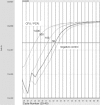Obstacles of Multiplex Real-Time PCR for Bacterial 16S rDNA: Primer Specifity and DNA Decontamination of Taq Polymerase
- PMID: 20737013
- PMCID: PMC2914405
- DOI: 10.1159/000265571
Obstacles of Multiplex Real-Time PCR for Bacterial 16S rDNA: Primer Specifity and DNA Decontamination of Taq Polymerase
Abstract
BACKGROUND: The detection of a broad range of bacteria by PCR is applied for the screening of blood and blood products with special attention to platelet concentrates. For practical use it is desirable that detection systems include Gram-positive, Gram-negative and non-Gram-stainable bacteria. It is quite challenging to achieve high sensitivity along with a clear negative control with PCR reagents, because especially Taq polymerase is contaminated with traces of bacterial DNA. METHODS: Bacterial DNA decontamination of Taq polymerase was attempted by two different methods using the restriction enzyme Sau 3A1 and microfiltration. Additionally a commercially available Taq polymerase depleted of bacterial DNA was included. A published real-time PCR specific for Gram-negative bacteria was adapted for Gram-positive bacteria, including certain Staphylococcus species and Mycobacteria, and was used to charge the three Taq polymer-ases depleted of bacterial DNA contamination RESULTS: Despite published reports about successful DNA decontamination, all three approaches performed poorly in experiments done in this study. Sensitivity ranged at approximately 50-100 colony forming units (CFU) per PCR reaction for Escherichia coli and Staphylococcus epidermidis, corresponding to 1,250-2,500 CFU/ml sample material. Conclusion: It seems unsatisfying to accept detection limits that high for diagnostic bacterial PCR even if highly multiplexed. Reliable methods for DNA decontamination of Taq polymerase are needed and would present one important step towards bacterial DNA detection with high sensitivity.
Hintergrund: Die Detektion eines breiten Spektrums verschiedener Bakterien mittels PCR wird bei der Untersuchung von Blut und Blutprodukten eingesetzt und ist bei der Untersuchung von Thrombozytenkonzentraten von besonderem Interesse. Aus praktischen Erwägungen erscheint ein Detektionssystem wünschenswert, das sowohl grampositive und gramnegative, als auch nichtgramfärbbare Bakterien erkennt. Der Wunsch nach hoher Sensitivität bei gleichzeitig eindeutigen Negativkontrollen stellt hierbei eine ganz besondere Herausforderung dar, weil die verwendeten PCR-Reagenzien und ganz besonders die Taq-Polymerase selbst, immer mit Spuren bakterieller DNA verunreinigt sind.
Methoden: Die Abreicherung bakterieller DNA in Taq-Polymerase wurde durch zwei Methoden – den Einsatz des Restriktionsenzyms Sau 3A1 bzw. Mikrofiltration - versucht. Zusätzlich wurde eine kommerziell erhältliche Taq-Polymerase mit angeblich bereits reduziertem Bakterien-DNA-Gehalt in der Studie eingeschlossen. Eine publizierte «Real-time»-PCR-Methode, die vor allem für die Detektion gramnegativer Bakterien geeignet schien, wurde um die Erkennung grampositiver Bakterien erweitert und erlaubte so schlussendlich auch die Detektierung von Spezies der Gattungen Staphylococcus und Mycobacteria. Diese PCR wurde für die Beurteilung der drei verschiedenen Taq-Polymerasen und der Abreicherung bakterieller DNA eingesetzt.
Ergebnisse: Trotz bereits publizierter Berichte über erfolgreiche DNA-Dekontamination enttäuschten alle drei in dieser Studie geprüften Ansätze. Die erreichte Sensitivität lag bei zirka 50-100 Colony Forming Units (CFU) pro PCR-Reaktion für Escherichia coli und Staphylococcus epidermidis, was 1,250-2,500 CFU/ml Probenmaterial entsprach.
Schlussfolgerung: Trotz Mehrfachspezifität der verwendeten diagnostischen PCR erscheinen die erreichten Detektionslimits unbefriedigend hoch. Nach wie vor besteht ein Bedarf an verlässlichen Methoden für die DNA-Dekontamination von Taq-Polymerase, um eine hohe Sensitivität bei der Detektion bakterieller DNA zu erreichen.
Figures


Similar articles
-
Development of an ethidium monoazide-enhanced internally controlled universal 16S rDNA real-time polymerase chain reaction assay for detection of bacterial contamination in platelet concentrates.Transfusion. 2012 Jul;52(7):1423-32. doi: 10.1111/j.1537-2995.2011.03484.x. Epub 2011 Dec 21. Transfusion. 2012. PMID: 22188457
-
An efficient strategy for broad-range detection of low abundance bacteria without DNA decontamination of PCR reagents.PLoS One. 2011;6(5):e20303. doi: 10.1371/journal.pone.0020303. Epub 2011 May 26. PLoS One. 2011. PMID: 21637859 Free PMC article.
-
[A broad-range 16S rRNA gene real-time PCR assay for the diagnosis of neonatal septicemia].Zhonghua Er Ke Za Zhi. 2007 Jun;45(6):446-9. Zhonghua Er Ke Za Zhi. 2007. PMID: 17880793 Chinese.
-
Applications of real-time PCR in the screening of platelet concentrates for bacterial contamination.Expert Rev Mol Diagn. 2006 Nov;6(6):865-72. doi: 10.1586/14737159.6.6.865. Expert Rev Mol Diagn. 2006. PMID: 17140373 Review.
-
Real-time polymerase chain reaction in transfusion medicine: applications for detection of bacterial contamination in blood products.Transfus Med Rev. 2007 Jul;21(3):237-54. doi: 10.1016/j.tmrv.2007.03.006. Transfus Med Rev. 2007. PMID: 17572262 Review.
Cited by
-
Preparation of Phi29 DNA polymerase free of amplifiable DNA using ethidium monoazide, an ultraviolet-free light-emitting diode lamp and trehalose.PLoS One. 2014 Feb 5;9(2):e82624. doi: 10.1371/journal.pone.0082624. eCollection 2014. PLoS One. 2014. PMID: 24505243 Free PMC article.
-
As for the Past, as for 2010.Transfus Med Hemother. 2010 Feb;37(1):5-6. doi: 10.1159/000279152. Transfus Med Hemother. 2010. PMID: 20737010 Free PMC article. No abstract available.
-
Amplification of bacterial genomic DNA from all ascitic fluids with a highly sensitive polymerase chain reaction.Mol Med Rep. 2018 Aug;18(2):2117-2123. doi: 10.3892/mmr.2018.9159. Epub 2018 Jun 14. Mol Med Rep. 2018. PMID: 29901148 Free PMC article.
-
Evaluation of a microfluidic-based point-of-care prototype with customized chip for detection of bacterial clusters.Microbiol Spectr. 2024 Nov 6;12(12):e0086224. doi: 10.1128/spectrum.00862-24. Online ahead of print. Microbiol Spectr. 2024. PMID: 39503490 Free PMC article.
-
Rapid identification of pathogens from positive blood cultures by multiplex polymerase chain reaction using the FilmArray system.Diagn Microbiol Infect Dis. 2012 Dec;74(4):349-55. doi: 10.1016/j.diagmicrobio.2012.08.013. Epub 2012 Sep 19. Diagn Microbiol Infect Dis. 2012. PMID: 22999332 Free PMC article.
References
-
- Mothershed EA, Whitney AM. Nucleic acid-based methods for the detection of bacterial pathogens: present and future considerations for the clinical laboratory. Clin Chim Acta. 2006;363(1-2):206–20. - PubMed
-
- Barken KB, Haagensen JA, Tolker-Nielsen T. Advances in nucleic acid-based diagnostics of bacterial infections. Clin Chim Acta. 2007;384(1-2):1–11. - PubMed
-
- Zhang T, Fang HH. Applications of real-time polymerase chain reaction for quantification of microorganisms in environmental samples. Appl Microbiol Biotechnol. 2006;70(3):281–9. - PubMed
-
- Rand KH, Houck H. Taq polymerase contains bacterial DNA of unknown origin. Mol Cell Probes. 1990;4(6):445–50. - PubMed
LinkOut - more resources
Full Text Sources
Other Literature Sources

